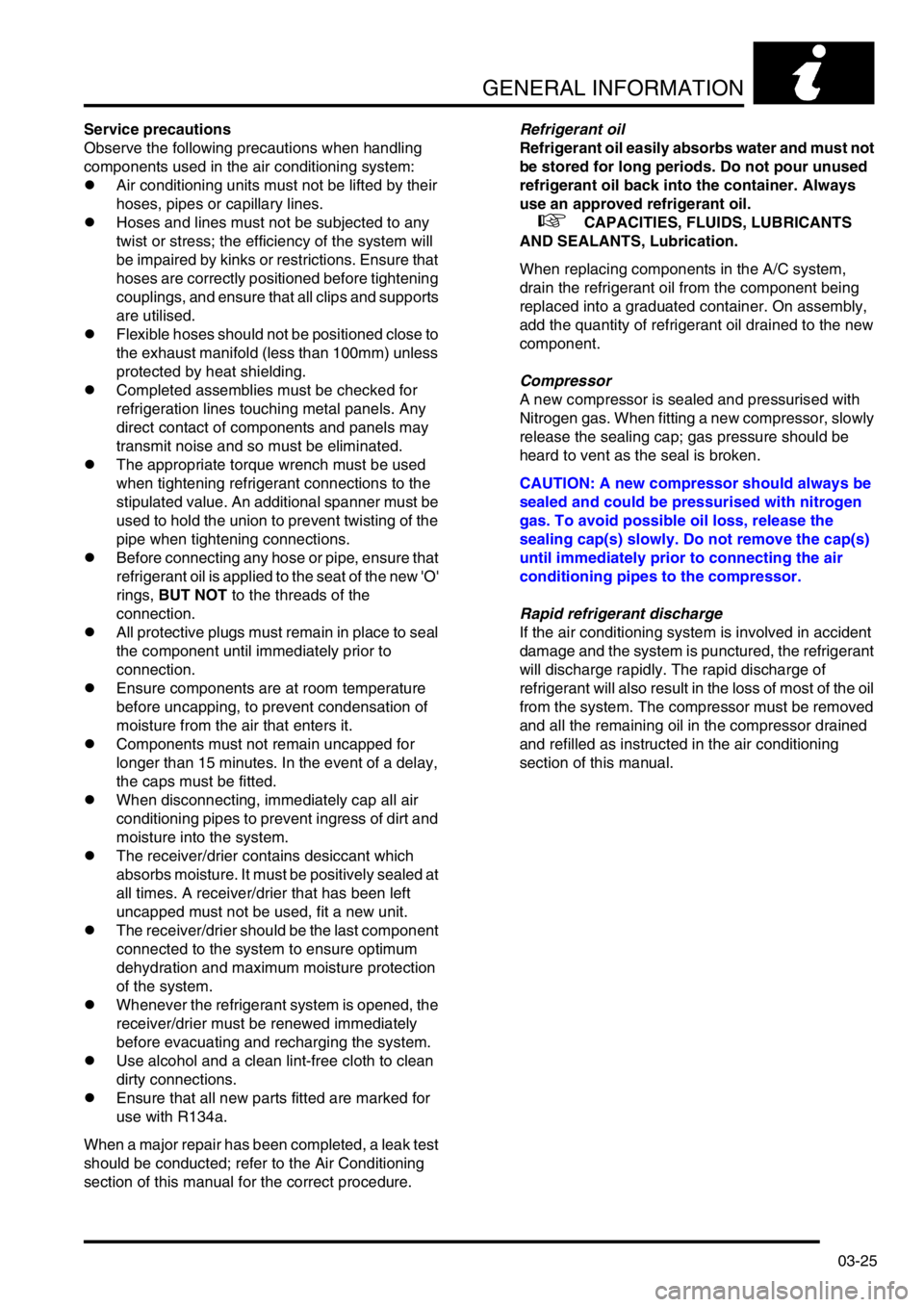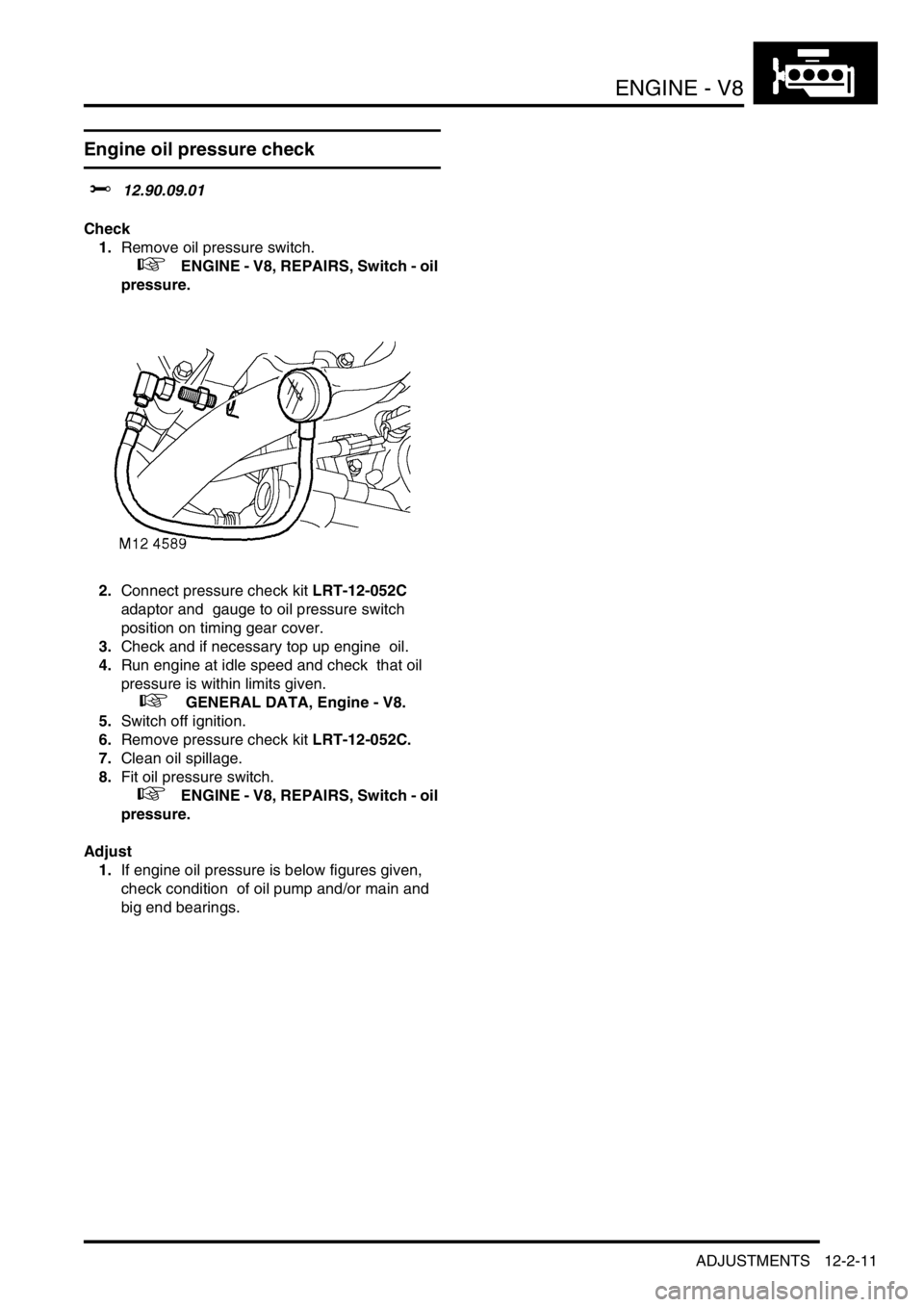low oil pressure LAND ROVER DISCOVERY 1999 Workshop Manual
[x] Cancel search | Manufacturer: LAND ROVER, Model Year: 1999, Model line: DISCOVERY, Model: LAND ROVER DISCOVERY 1999Pages: 1529, PDF Size: 34.8 MB
Page 60 of 1529

GENERAL INFORMATION
03-25
Service precautions
Observe the following precautions when handling
components used in the air conditioning system:
lAir conditioning units must not be lifted by their
hoses, pipes or capillary lines.
lHoses and lines must not be subjected to any
twist or stress; the efficiency of the system will
be impaired by kinks or restrictions. Ensure that
hoses are correctly positioned before tightening
couplings, and ensure that all clips and supports
are utilised.
lFlexible hoses should not be positioned close to
the exhaust manifold (less than 100mm) unless
protected by heat shielding.
lCompleted assemblies must be checked for
refrigeration lines touching metal panels. Any
direct contact of components and panels may
transmit noise and so must be eliminated.
lThe appropriate torque wrench must be used
when tightening refrigerant connections to the
stipulated value. An additional spanner must be
used to hold the union to prevent twisting of the
pipe when tightening connections.
lBefore connecting any hose or pipe, ensure that
refrigerant oil is applied to the seat of the new 'O'
rings, BUT NOT to the threads of the
connection.
lAll protective plugs must remain in place to seal
the component until immediately prior to
connection.
lEnsure components are at room temperature
before uncapping, to prevent condensation of
moisture from the air that enters it.
lComponents must not remain uncapped for
longer than 15 minutes. In the event of a delay,
the caps must be fitted.
lWhen disconnecting, immediately cap all air
conditioning pipes to prevent ingress of dirt and
moisture into the system.
lThe receiver/drier contains desiccant which
absorbs moisture. It must be positively sealed at
all times. A receiver/drier that has been left
uncapped must not be used, fit a new unit.
lThe receiver/drier should be the last component
connected to the system to ensure optimum
dehydration and maximum moisture protection
of the system.
lWhenever the refrigerant system is opened, the
receiver/drier must be renewed immediately
before evacuating and recharging the system.
lUse alcohol and a clean lint-free cloth to clean
dirty connections.
lEnsure that all new parts fitted are marked for
use with R134a.
When a major repair has been completed, a leak test
should be conducted; refer to the Air Conditioning
section of this manual for the correct procedure.Refrigerant oil
Refrigerant oil easily absorbs water and must not
be stored for long periods. Do not pour unused
refrigerant oil back into the container. Always
use an approved refrigerant oil.
+ CAPACITIES, FLUIDS, LUBRICANTS
AND SEALANTS, Lubrication.
When replacing components in the A/C system,
drain the refrigerant oil from the component being
replaced into a graduated container. On assembly,
add the quantity of refrigerant oil drained to the new
component.
Compressor
A new compressor is sealed and pressurised with
Nitrogen gas. When fitting a new compressor, slowly
release the sealing cap; gas pressure should be
heard to vent as the seal is broken.
CAUTION: A new compressor should always be
sealed and could be pressurised with nitrogen
gas. To avoid possible oil loss, release the
sealing cap(s) slowly. Do not remove the cap(s)
until immediately prior to connecting the air
conditioning pipes to the compressor.
Rapid refrigerant discharge
If the air conditioning system is involved in accident
damage and the system is punctured, the refrigerant
will discharge rapidly. The rapid discharge of
refrigerant will also result in the loss of most of the oil
from the system. The compressor must be removed
and all the remaining oil in the compressor drained
and refilled as instructed in the air conditioning
section of this manual.
Page 65 of 1529

GENERAL DATA
04-2
Lubrication
Type Wet sump, pressure fed
Pump type Eccentric rotor, crankshaft driven integral with stiffener plate.
Filter type:
⇒ Primary Centrifuge filter
⇒ Secondary Disposable canister with full flow by-pass
Pressure at idle (Cold) 3.0 bar (43.5 lbf.in
2)
Pressure at 3500 rev/min (Hot) 1.5-3.0 bar (21.75-43.5 lbf.in
2)
Relief valve opening pressure 4.0 bar (58 lbf.in
2)
Low oil pressure switch opening pressure 0.2-0.6 bar (3.0-8.8 lbf.in
2)
Crankshaft
Main journal diameter 61.9875-62.0125 mm (2.4404-2.4414 in)
Crankpin journal diameter 53.99-54.01 mm (2.125-2.131 in)
End float 0.020 - 0.250 mm (0.0008 - 0.0098 in)
Main bearings
Quantity 6 (5 main, 1 thrust)
Pistons
Type Graphite compound skirt with combustion chamber in crown
Clearance in cylinder bore.
Measured at bottom of skirt, 90° to gudgeon pin0.172-0.206 mm (0.007-0.008 in)
Diameter
(Measured at right angles to gudgeon pin and 40.0 mm
(1.5 in) from bottom of skirt)84.270-85.254 mm (3.321-3.361 in)
Gudgeon pins Fully floating, offset towards piston thrust side
Piston rings
Type: 2 compression, 1 oil control
⇒ Upper compression ring Barrel edge, chrome plated
⇒ Lower compression ring Taper faced
⇒ Oil control ring Bevelled ring with spring
New ring to groove clearance:
⇒ Upper compression Not measured
⇒ Lower compression 0.050-0.082 mm (0.002-0.003 in)
⇒ Oil control 0.050-0.082 mm (0.002-0.003 in)
Piston ring fitted gap in cylinder bore:
⇒ Upper compression 0.30-0.45 mm (0.0118-0.0177 in)
⇒ Lower compression 0.40-0.60 mm (0.0157-0.0236 in)
⇒ Oil control 0.25-0.40 mm (0.0098-0.0157 in)
Camshaft
Bearings 6
Drive Duplex chain
End float 0.06-0.16 mm (0.002-0.006 in)
Tappets
Type Hydraulic lash adjusters with followers
Page 68 of 1529

GENERAL DATA
04-5
Idle speed:
⇒ All loads off 660 ± 50 rev/min
⇒ Base idle speed Non-adjustable
⇒ Idle air control (IAC) valve position Checked via TestBook
CO at idle:
⇒ Catalyst vehicles 0.5 %
⇒ Non-catalyst vehicles 0.5 - 1.0 %
Valve timing
Inlet valves:
⇒ Opens 28° BTDC
⇒ Closes 77° ABDC
Exhaust valves:
⇒ Opens 66° BBDC
⇒ Closes 39° ATDC
Fuel grade:
⇒ High compression catalyst vehicles 95 RON minimum unleaded
⇒ Low compression catalyst vehicles 91 RON minimum unleaded
⇒Non-catalyst vehicles 97 RON leaded
Lubrication
Type Wet sump, pressure fed
Pump type Crankshaft driven eccentric rotor
Oil filter Disposable canister with full flow by-pass
Pressure at idle - minimum 0.7 bar (10 lbf.in
2)
Pressure at 2000 rev/min (hot) 3.4 bar (50 lbf.in
2)
Relief valve opening pressure 3.4 bar (50 lbf.in
2)
Low oil pressure switch opening pressure 0.24-0.41 bar (3.5-6.0 lbf.in
2)
Crankshaft
Main journal diameter 63.487 - 63.500 mm (2.4995 - 2.520 in)
Crankpin journal diameter 55.500 - 55.513 mm (2.20 - 2.22 in)
End float 0.08 - 0.26 mm (0.003 - 0.010 in)
Maximum ovality 0.040 mm (0.002 in)
Main bearings
Quantity 5
Material Glacier Vandervell / AS 15
Diametrical clearance 0.015 - 0.016 mm (0.00059 - 0.00063 in)
Connecting Rods
Type Horizontally split big-end, plain small end
Distance between centres 155.120 - 155.220 mm (6.1071 - 6.1110 in)
Big-end bearings
Quantity 8
Material Glacier Vandervell GPL 2120/AS 124A
Diametrical clearance 0.015 - 0.016 mm (0.00059 - 0.00063 in)
End float 0.15 - 0.35 mm (0.0006 - 0.0138 in)
Page 84 of 1529

GENERAL DATA
04-21
Air conditioning
Type CFC free, sealed closed loop
Compressor:
⇒ Displacement 177.7 cm
3/rev (10.84 in3/rev)
⇒ Relief valve operating pressure 34.3 to 41.4 bar (497 to 600 lbf.in
2)
⇒ Refrigerant oil quantity 180ml (6.3 fl.oz)
Dual pressure switch operating pressures (nominal):
⇒ Low pressure switch Opens 2.0 bar (29.0 lbf.in
2), pressure decreasing
⇒ Low pressure switch Closes 2.3 bar (33.4 lbf.in
2), pressure increasing
⇒ High pressure switch Opens 32 bar (464 lbf.in
2), pressure increasing
⇒ High pressure switch Closes 26 bar (377 lbf.in
2), pressure decreasing
Page 97 of 1529

TORQUE WRENCH SETTINGS
06-6
Engine management system - Td5
Engine management system - V8
+ Apply sealant, Part No. STC 50552 to threads
TORQUE DESCRIPTION METRIC IMPERIAL
ECT sensor15 Nm (11 lbf.ft)
Fuel tank cradle45 Nm (33 lbf.ft)
CKP sensor10 Nm (7 lbf.ft)
MAP and IAT sensor 10 Nm (7 lbf.ft)
Fuel cooler to inlet manifold - upper bolts 25 Nm (18 lbf.ft)
Turbocharger to exhaust manifold 30 Nm (22 lbf.ft)
Turbocharger drain pipe 10 Nm (7 lbf.ft)
Banjo bolt to oil feed pipe 25 Nm (18 lbf.ft)
Fuel temperature sensor 14 Nm (10 lbf.ft)
Pressure regulator 25 Nm (18 lbf.ft)
Glow plugs16 Nm (12 lbf.ft)
EUI clamp bolts32 Nm (24 lbf.ft)
EGR valve to exhaust manifold 10 Nm (7 lbf.ft)
EGR valve to inlet manifold 10 Nm (7 lbf.ft)
EGR clip25 Nm (18 lbf.ft)
TORQUE DESCRIPTION METRIC IMPERIAL
Spark plugs20 Nm (15 lbf.ft)
Fuel tank cradle45 Nm (33 lbf.ft)
ECT sensor +10 Nm (7 lbf.ft)
CKP sensor6 Nm (4.4 lbf.ft)
CMP sensor8 Nm (6 lbf.ft)
KS sensor22 Nm (16 lbf.ft)
Throttle body10 Nm (7 lbf.ft)
Plenum chamber22 Nm (16 lbf.ft)
Breather adaptor6 Nm (4.4 lbf.ft)
Throttle cable abutment bracket 10 Nm (7 lbf.ft)
TP sensor 2.2 Nm (1.6 lbf.ft)
IACV sensor8 Nm (6 lbf.ft)
HO
2S sensor45 Nm (33 lbf.ft)
Ignition coils8 Nm (6 lbf.ft)
Fuel rail9 Nm (7 lbf.ft)
Page 121 of 1529

CAPACITIES, FLUIDS, LUBRICANTS AND SEALANTS
09-4
Gearbox oil
Manual Gearbox: Use Texaco MTF 94 oil for refill
and topping-up.
Automatic Gearbox: Use Texamatic 9226, ATF
Dexron 11D or Dexron 111 for refill and topping-up
Transfer box
Use Texaco Multi-Gear 75W/90R or oil meeting
specification API GL5.
Front and rear axles
Use Texaco Multi-Gear 75W/90R.
Air Conditioning
Use lubricating oil Nippon Denso ND-8.
General Greasing
Use Multipurpose Lithium Base Grease N.L.G.I.
consistency No. 2.
Bonnet latch
Lubricate cable and latch with oil.
Sealants
The following table lists those sealants which are
used during repair / overhaul procedures covered in
this manual; it is essential that the sealant specified
for a particular procedure is used at all times.
Component Application Land Rover
Part No.
Td5 Engine Timing chain fixed
guide Allen screwSTC 50552
Td5 Engine Camshaft cover
gasket joint lineSTC 50550
Td5 Engine Oil pick-up strainer
Torx screwsSTC 50552
Td5 Engine Oil pump drive
sprocket retaining
boltSTC 50552
Td5 Engine Timing chain cover,
crankshaft rear oil
seal and sump
gasket joint linesSTC 50550
Td5 Engine Oil pressure relief
valve plugSTC 50552
Td5 Engine Camshaft carrier to
cylinder headSTC 4600
Td5 Engine Timing cover STC 50550
V8 Engine Sump gasket to
cylinder blockSTC 50550
V8 Engine 'V' grooves at end
of cylinder head -
Inlet manifold
gasketSTC 50550
V8 Engine Cruciform seal
endsSTC 50550
V8 Engine Dipstick tube STC 50554
V8 Engine Timing cover bolts STC 50552
Engine
Management
System - V8Engine coolant
temperature (ECT)
sensor threadsSTC 50552
Manifolds and
Exhaust
System - V8'V' grooves at end
of cylinder head -
Inlet manifold
gasketSTC 50550
Manual
Gearbox -
R380Gear selector
housingSTC 4404
Manual
Gearbox -
R380Selector housing
boltsSTC 50552
Manual
Gearbox -
R380Input shaft oil seal
housingSTC 4404
Manual
Gearbox -
R380Reverse inhibitor
shaft threadsSTC 50552
Page 160 of 1529

ENGINE - V8
DESCRIPTION AND OPERATION 12-2-5
1Core plugs
2Cylinder block
3Camshaft
4Dipstick tube, clamp and bolt
5Woodruff key
6Timing chain
7Camshaft timing gear
8Washer
9Bolt - camshaft timing gear
10Thrust plate - camshaft end-float
11Bolt - camshaft thrust plate
12Gasket - timing cover
13Timing cover
14Oil pressure switch
15Bolt
16Crankshaft front oil seal
17Oil filter element
18Crankshaft front pulley
19Washer
20Bolt - crankshaft front pulley
21Upper main bearing shell
22Upper centre main bearing shell and thrust
washer
23Crankshaft
24Woodruff key
25Crankshaft timing gear
26Lower main bearing shells
27Numbers 1, 2 and 3 main bearing caps
28Bolt - main bearing caps
29Oil pick-up pipe and strainer30'O' ring
31Bolt - oil pick-up pipe
32Gasket - sump
33Sump
34Bolt - sump
35Sump oil drain plug
36Sealing washer
37Spacer, washers and nut - oil pick-up pipe
38Number 4 main bearing cap
39Bolt - connecting rod big-end bearing cap
40Connecting rod big-end bearing shell - lower
41Connecting rod big-end bearing cap
42Number 5 - rear main bearing cap
43Cruciform seal - rear main bearing cap
44Number 5 - rear main bearing shell
45Crankshaft rear oil seal
46Crankshaft knock sensor
47Side bolt - main bearing cap
48Side Allen bolt - main bearing cap
49Dowty washers
50Connecting rod big-end bearing shell - upper
51Connecting rod
52Piston
53Gudgeon pin
54Oil control ring
55Top compression ring
562nd compression ring
57Flywheel/drive plate and starter ring gear
58Bolt - flywheel/drive plate
Page 161 of 1529

ENGINE - V8
12-2-6 DESCRIPTION AND OPERATION
Description
General
The V8 petrol engine is an eight cylinder, water cooled unit having two banks of four cylinders positioned at 90 degrees
to each other. The engine comprises five main castings - two cylinder heads, cylinder block, timing cover and the oil
sump, all of which are manufactured from aluminium alloy.
NAS market vehicles from 03 model year receive a 4.6 litre version of the V8 engine to replace the previous 4.0 litre
version.
Cylinder heads
The cylinder heads are fitted with replaceable valve guides and valve seat inserts with the combustion chambers
formed in the head. Each cylinder head is sealed to the cylinder block with a gasket. The exhaust manifolds are bolted
to the outside of each cylinder head whilst the inlet manifolds are located in the centre of the 'Vee' and are bolted to
the inside face of each head. Inlet and exhaust manifolds are sealed to the cylinder heads by means of gaskets.
Each cylinder has a single inlet and exhaust valve. The exhaust valves are of the 'carbon break' type, a recess on the
valve stem prevents a build-up of carbon in the valve guide by dislodging particles of carbon as the valve stem moves
up and down the guide. Inlet and exhaust valve stem oil seals are fitted at the top of each valve guide. Valve operation
is by means of rocker arms, push rods and hydraulic tappets. Each of the rocker arms is located on a rocker shaft
which is supported by means of pedestals bolted to the cylinder heads. A spring, positioned on either side of each
rocker arm, maintains the correct relative position of the arm to its valve stem. The rocker arms are operated directly
by the push rods which pass through drillings in the cylinder heads and cylinder block. The bottom end of each push
rod locates in a hydraulic tappet operated by the single, chain driven camshaft.
The rocker covers are bolted to the cylinder heads and are sealed to the heads by a rubber gasket. Stub pipes for
crankcase ventilation hose connections are fitted to each rocker cover, the pipe in the right hand cover incorporates
an oil separator. The engine oil filler cap is situated in the right hand cover.
Cylinder block and camshaft
The cylinder block is fitted with cast iron cylinder liners which are shrink fitted and locate on stops in the block. The
camshaft is positioned in the centre of the cylinder block and runs in one piece bearing shells which are line bored
after fitting. Camshaft end-float is controlled by a thrust plate bolted to the front of the cylinder block. A timing gear,
chain driven by the crankshaft timing gear is bolted to the front of the camshaft.
Crankshaft and main bearings
The crankshaft is carried in five main bearings. The upper main bearing shell locations are an integral part of the
cylinder block casting. The lower main bearing caps are bolted to the cylinder block on either side of the upper bearing
shell locations with an additional bolt being inserted into each cap from either side of the cylinder block. The rear
main bearing cap carries the crankshaft rear oil seal and is sealed to the cylinder block by means of cruciform shaped
seals in each side of the cap. Number four main bearing cap carries the stud fixing for the oil pick-up pipe. Lower
main bearing shells are plain whilst the upper shells have an oil feed hole and are grooved. Crankshaft end-float is
controlled by the thrust faces of the upper centre shell. The crankshaft timing gear is located on the front of the
crankshaft by means of a Woodruff key which is also used to drive the gear type oil pump. The flywheel/drive plate
carries the crankshaft position sensor reluctor ring and is dowel located and bolted to the flywheel.
Timing cover
The timing cover is bolted to the front of the cylinder block and is sealed to the block with a gasket. The disposable,
full flow oil filter canister is screwed on to the timing cover which also carries the oil pressure switch, oil pressure relief
valve and crankshaft front oil seal. The gear type oil pump is integral with the cover which also has an internal oilway
to direct oil from the oil cooler to the filter.
NOTE: Oil coolers are only fitted to vehicles up to VIN 756821.
Page 164 of 1529

ENGINE - V8
DESCRIPTION AND OPERATION 12-2-9
Oil is drawn from the sump through a strainer and into the oil pump via the oil pick-up pipe. Pressurised oil from the
pump passes through the oil cooler (if fitted) mounted in front of the radiator and returns to the full flow oil filter
element. Oil from the filter passes into the main oil gallery and through internal drillings to the crankshaft where it is
directed to each main bearing and to the big-end bearings via numbers 1, 3 and 5 main bearings. An internal drilling
in the cylinder block directs oil to the camshaft where it passes through further internal drillings to the hydraulic
tappets, camshaft bearing journals and rocker shafts. Lubrication to the pistons, small ends and cylinder bores is by
oil grooves machined in the connecting rods and by splash.
Oil pressure switch
The oil pressure warning light switch registers low oil pressure in the main oil gallery on the outflow side of the filter.
Whilst the engine is running and oil pressure is correct, the switch is open. When the ignition is switched on or if oil
pressure drops below the pressure setting of the switch, the switch closes and the low oil pressure warning lamp
located in the instrument pack will illuminate.
Hydraulic tappets
1Clip
2Pushrod seat
3Inner sleeve
4Upper chamber5Non-return ball valve
6Spring
7Outer sleeve
8Lower chamber
The hydraulic tappet provides maintenance free, quiet operation of the valves. This is achieved by utilizing engine oil
pressure to eliminate the clearance between the rocker arms and valve stems. When the valve is closed, engine oil
pressure present in the upper chamber, passes through the non-return ball valve and into the lower chamber. When
the cam begins to lift the outer sleeve, the resistance of the valve spring, felt through the push rod and seat, causes
the tappet inner sleeve to move downwards inside the outer sleeve. This downwards movement closes the non-return
ball valve and increases the pressure in the lower chamber sufficiently to ensure that the valve is fully opened by the
push rod. As the tappet moves off the peak of the cam, the non-return ball valve opens thereby allowing the pressure
in both chambers to equalize. This ensures that the valve will be fully closed when the tappet is on the back of the
cam.
Crankcase ventilation
A positive crankcase ventilation system is used to vent crankcase gases to the air induction system. Gases are drawn
from the left hand rocker cover to a tapping in the throttle body. An oil separator is incorporated in the hose connection
stub pipe in the right hand rocker cover, gases from this connection are drawn to a tapping in the inlet manifold.
+ EMISSION CONTROL - V8, DESCRIPTION AND OPERATION, Crankcase Emission Control System.
Page 166 of 1529

ENGINE - V8
ADJUSTMENTS 12-2-11
ADJUST ME NTS
Engine oil pressure check
$% 12.90.09.01
Check
1.Remove oil pressure switch.
+ ENGINE - V8, REPAIRS, Switch - oil
pressure.
2.Connect pressure check kit LRT-12-052C
adaptor and gauge to oil pressure switch
position on timing gear cover.
3.Check and if necessary top up engine oil.
4.Run engine at idle speed and check that oil
pressure is within limits given.
+ GENERAL DATA, Engine - V8.
5.Switch off ignition.
6.Remove pressure check kit LRT-12-052C.
7.Clean oil spillage.
8.Fit oil pressure switch.
+ ENGINE - V8, REPAIRS, Switch - oil
pressure.
Adjust
1.If engine oil pressure is below figures given,
check condition of oil pump and/or main and
big end bearings.